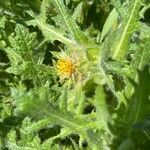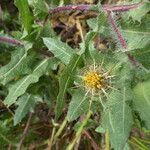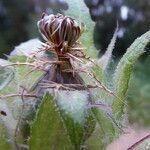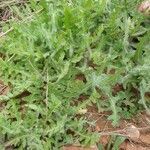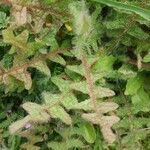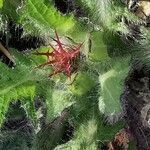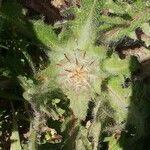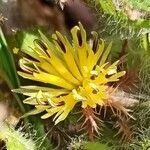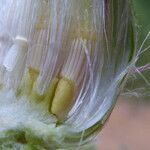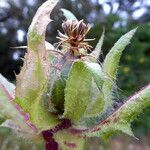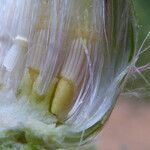Annuals, to 60 cm. Stems often spreading or prostrate, usually branched throughout, usually reddish, ± loosely tomentose. Leaves mostly cauline, sessile and often short-decurrent or proximal tapering to winged petioles, blades lanceolate to oblanceolate, 6–25 cm, margins coarsely dentate or pinnately lobed, lobes and teeth armed with short, weak spines, faces sparsely to densely hairy with jointed multicellular hairs and slender cobwebby hairs, resin-gland-dotted. Heads disciform, borne singly, sessile, each subtended by involucre-like cluster of leaf-like bracts. Involucres ± spheric, 20–40 mm. Phyllaries in several series, tightly overlapping, outer ovate with tightly appressed bases and spreading spine tips, inner lanceolate, tipped by pinnately divided spines more than 5 mm. Florets many; corollas yellow, those of sterile florets linear, 3-lobed, not exceeding disc corollas, very slender, those of disc florets 19–24 mm. Cypselae cylindric, slightly curved, 8–11 mm, with 20 prominent ribs, tipped by a 10-dentate rim, glabrous, attachment scars lateral; pappi of 2 series of awns, outer 9–10 mm, smooth or ± roughened, inner 2–5 mm, roughened with short spreading hairs. 2n = 22.
Annual or biennial to 0.3 m high. Stems with sparse arachnoid and multicellular hairs; wings absent. Cauline leaves elliptic, sinuate, toothed (teeth 0.5–1.5 mm long), green above and below, with sparse multicellular hairs; sessile glands present. Capitula solitary, sessile; involucre subglobose, 15–25 mm diam. at anthesis, surrounded and partly obscured by foliose bracts; median involucral bracts ovate, 10–12 mm long, 5–6 mm wide, glabrous or with sparse arachnoid hairs; appendages 8–16 mm long, with spreading pectinate spines. Florets yellow; inner (fertile) florets with tube 7–12 mm long, not glandular, and lobes 2–4 mm long; sterile florets longer than fertile florets. Anthers 3.5–4.5 mm long. Achenes cylindrical, 7.2–8.5 mm long, glabrous, grey, longitudinally ribbed. Pappus in 2 rows each of 10 awns; outer awns 10–11 mm long, aristate; inner awns 2.3–3 mm long, fimbriate.
A medium sized annual thistle. It is softly hairy. The stems are usually only branched at the base. They are reddish-purple. The leaves are alternate and oblong. They are pale green. The veins underneath and prominent and white. The leaves at the base are often in a ring. They are divided into lobes along the stalk. These lower leaves have stalks. The upper leaves are smaller and partly clasp the stem. There are tips at the spine. The flower heads are yellow and pale green. They are 25-40 mm long. They occur singly. The florets are smaller, tube shaped and surrounded by a ruff of small upper leaves.
